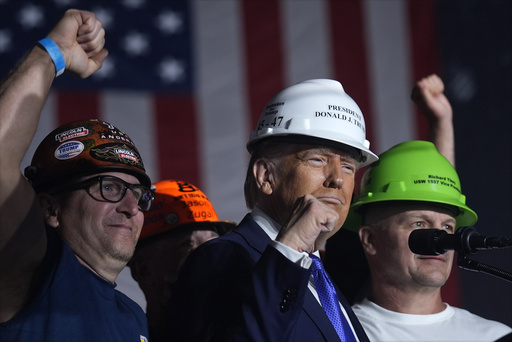
“`html
WEST PALM BEACH, Fla. — In January 2021, as he prepared to leave Washington amidst low popularity and a loss in the presidential race, Donald Trump was already signaling a possible return, stating, “Goodbye. We love you. We will be back in some form” to his loyal supporters at Joint Base Andrews.
Fast forward four years, and Trump has indeed made a spectacular comeback. In a stunning victory against Vice President Kamala Harris, Trump has achieved what many deemed impossible after his tumultuous departure, which included the Capitol riots led by his supporters in protest of his defeat.
Despite facing severe legal challenges over the past years, including four indictments, a conviction on multiple felony counts, and a civil judgment for inflating his assets, Trump managed to transform these adversities into a rallying point for voters. He tapped into a pervasive dissatisfaction among the populace over rising inflation and the overall state of the nation. Utilizing social media and podcasts, he reached out to disillusioned Americans, assuring them that he understood their frustrations with the current leadership.
Trump’s campaign weathered numerous challenges including two assassination attempts and a dramatic late-stage candidate switch by the Democrats from President Biden to Harris, who made history as the first woman of color to lead a major-party ticket.
“This was a campaign of October surprises,” expressed Chris LaCivita, a senior adviser to Trump’s campaign, shortly after they celebrated their victory. “From indictments to attempts on his life, it was unprecedented on multiple fronts.”
Initially, Trump dominated the Republican primaries, effortlessly outpacing a large pool of contenders. Even with his legal issues garnering significant media attention, Trump positioned himself as the target of a politically motivated campaign aimed at undermining him, garnering the loyalty of his supporters who were eager to defend him.
In late June, a debate against President Biden, which was greatly anticipated by the Biden campaign, ended poorly for the sitting president, who struggled throughout, losing his focus and coherence. Subsequently, during the Republican National Convention, Trump appeared as a force to be reckoned with, having recently survived a barrage of gunfire at a rally in Butler, Pennsylvania. Surrounded by Secret Service, and with blood on his face, Trump raised his fist and encouraged his supporters to “Fight! Fight! Fight!” making it a memorable theme in his campaign.
Trump’s celebrity strategist Roger Stone remarked, “When you try to jail someone, it often makes them larger than life. Every challenge he faced only amplified his political stature.”
However, with a few short weeks until the election, the dynamics shifted when Biden, under pressure regarding his age and effectiveness, stepped aside, paving the way for Harris to take the lead. This caught Trump off guard, as he had dedicated time and resources to countering Biden, forcing him to recalibrating his strategy against a formidable opponent.
Feeling the pressure, Trump responded to critiques of Harris by making controversial comments about her racial identity, amplifying divisive narratives on his social platform. His team pivoted quickly, branding Harris as unserious and too liberal, targeting her enthusiastic messaging that contrasted sharply with a disillusioned electorate seeking tangible change.
Although Trump’s approval ratings were initially low after his presidency, increasing numbers during the subsequent years fueled his belief in a successful comeback. His advisers noted that while the “Harris honeymoon” might initially inspire hope, it would eventually wane.
Post-2020 election defeat, Trump’s focus shifted toward expanding his support base beyond just white working-class voters. His campaign worked hard to attract younger, minority voters, capitalizing on the internal rifts within the Democratic Party. Notably, Trump made an unexpected ally in Arab Americans, showcasing a willingness to engage communities previously alienated by his past rhetoric on immigration.
During rallies, Trump spoke directly to voters, promising economic reforms and targeting the cultural issues that resonated with young people, particularly around topics like transgender rights. Advertising campaigns directly challenged Harris’s progressive stances, attempting to sway younger voters, especially among Hispanic men.
In a strategic shift, Trump’s team focused efforts on reaching out to politically detached voters, utilizing unconventional approaches to campaign communication. Trump made appearances on popular podcasts, fostered viral moments, and even showcased his lighter side with stunts such as serving fans at a McDonald’s, which significantly boosted his public image.
The campaign’s core strategy revolved around low-propensity voters. Trump’s staff emphasized personal relatability through humor and engagement during events attended by young audiences. His ability to connect with supporters on an informal level helped maintain enthusiasm for his candidacy.
With a solid operational framework, his campaign adopted a disciplined approach this time around, avoiding the chaos that had plagued previous efforts. As election day neared, Trump’s team continued arranging rallies across critical states, including a highly anticipated event at Madison Square Garden, which faced unexpected backlash before fruition.
Despite difficulties, Trump capitalized on a pivotal mistake made by Biden, who deemed Trump’s supporters “garbage”. The Republican campaign seized the moment to humorously reframe the narrative, using props like a garbage truck to rid the image of negativity and bolster their messaging.
However, Trump’s campaign strategy was not without its controversies, as he made bold statements, often to the disbelief of his advisers. Nevertheless, he pressed forward with a recognizable routine, ultimately leading him to a triumphant election night at Mar-a-Lago when the results confirmed a comeback.
Amid friends and influential supporters, Trump declared, “This will forever be remembered as the day the American people regained control of their country,” firmly placing himself back in the political landscape.
“`
